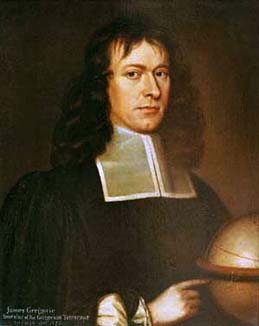The Gregorian Telescope was designed and invented by James Gregory who was a Scottish Mathematician and Astronomer of the 17th Century (1638 – 1675).
 He first proposed the design of the telescope in a publication called Optica Promota in 1663 but he didn’t successfully build his first telescope based on this design until about ten years later. (Here is a translation of the Optica Promota from the original Latin into English)
He first proposed the design of the telescope in a publication called Optica Promota in 1663 but he didn’t successfully build his first telescope based on this design until about ten years later. (Here is a translation of the Optica Promota from the original Latin into English)
At the time of its conception the Gregorian was a very successful and useful instrument and it was widely used, because of its good performance for over a century. The design has been much improved on though and this type of telescope is rarely used today but there are exceptions where the design is used.
James Gregory is credited as having designed the first practical Reflecting telescope.
It is named after him: “The Gregorian Telescope” and it still sees some limited use in today’s world.
The basic design of the scope was for it to have two mirrors. The first mirror (primary) was the main light gathering mirror. The light was bounced off this mirror to the second mirror (secondary) which is placed beyond the focal point of the primary. The light bouncing off this mirror then exits the telescope through a hole in the primary mirror.

The Light Path through a Gregorian Telescope
Table of Contents
The illustration above shows light as it travels through the telescope. It enters the tube at (A) then bounces off the primary mirror (D) which is a concave paraboloid. It travels to the secondary mirror (B) which is a concave ellipsoid. Note that mirror B is beyond the focal point (C) of the primary mirror. This position makes this telescope with the addition of an eyepiece an upright image viewer. Things observed through this telescope are right side up which is really nice for terrestrial observations. And a nice improvement over Newton’s telescope which inverted images.
https://www.youtube.com/watch?v=nOwzrNOdK0c
Some Disadvantages
The Gregorian Style Reflector has two concave mirrors which makes it more difficult to make than the newtonian. The newtonian has one concave and one flat mirror. In the Gregorian the primary mirror has to have a hole in the center of it which is also an additional challenge. Finally, the gregorian, because the secondary is beyond the focal point of the primary, is a longer (larger) telescope.
Noted advantages
Because the Gregorian telescope focuses the image before the secondary mirror a stop can be placed in the tube. This stop will limit the amount of light outside of view from reaching the secondary mirror. This is very advantageous with telescopes designed for solar observation where the stop will limit the amount of heat transmitted. Some modern day telescopes do use this set up and design. The Gregorian, unlike the refractor telescope is free of spherical and chromatic aberration.
The Gregorian design is still used in some telescopes for the secondary or smaller sighting telescope because of its unique erect image. But today, the Gregorian has been replaced by the better performing yet similar Cassegrain telescope.
Some Notable Modern Day Observatories that use the Gregorian Telescope Design
- The Vatican Advanced Technology Telescope and The Large Binocular Telescope at Mount Graham International Observatory in Arizona.
- The Gregorian design has also been used in Radio Telescopes such as the Green Bank Telescope at the NRAO in West Virginia and the Arecibo Radio telescope in Puerto Rico.
Modern Day Improvement on the Gregorian
Advances in optics and optical making equipment have brought about a design improvement to the Gregorian Design. This improvement is called The Compact Gregorian Reflector and it allows the telescope to be significantly smaller than the standard Gregorian. This type of telescope has found many uses.
